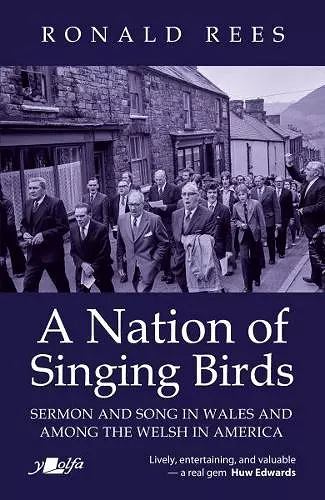A Nation of Singing Birds - Sermon and Song in Wales and Among the Welsh
Sermon and Song in Wales and Among the Welsh in America
Format:Paperback
Publisher:Y Lolfa
Published:10th Mar '21
Should be back in stock very soon

The history of the Welsh love of hymn singing, and of how hymns and the religious movements and revivals of which they were part fired the Welsh imagination and spread via Welsh emigrants to the religious communities of the USA.
The Welsh people are renowned for their love of songs and singing, above all the singing of hymns and forming choirs (which have to some extent by today superseded the age-old enthusiasm for religious congregations), and for their fondness of listening to sermons. These elements have also been powerfully perpetuated and enhanced in parts of America where the Welsh have settled in substantial numbers. In this groundbreaking original study, founded on a rich array of primary and secondary source materials, Ronald Rees has examined these preoccupations on both sides of the Atlantic. As a native of the south Wales valleys who migrated to north America, and an established academic and prolific historian, he is well equipped to undertake this task. The main theme of the book is the way in which hymns, and the various religious movements and revivals of which they were an intrinsic part for centuries, dramatically captured the imagination of the Welsh people – in Wales and in America – more than in any other nation. It was this overwhelming preoccupation which gave birth to the incomparable cymanfa ganu, so beloved in Wales in the nineteenth century, and a little later to the formation and popularity of choirs, above all the esteemed male voice choirs. These elements were replicated, too, across the Atlantic. Closely linked to these developments was the evolution of a specific genre of Welsh sermon with its distinctive emphasis on sound and delivery as much as content. The early chapters in this work examine the evolution of the hymn and a preoccupation with singing from the sixteenth century, with a particular emphasis on their centrality to the success of the circulating schools championed by Griffith Jones, Llanddowror, and the eighteenth-century Methodist revival where the hymns of William Williams, Pantycelyn, occupied a central place, and closely paralleled in England by the role of Isaac Watts and the Wesley brothers, who also travelled to America in 1736–38. The author demonstrates how the proliferation of the nonconformist denominations in nineteenth-century Wales, first and foremost the Methodists, meant that by about 1880 a distinctive fondness for the hymn and congregational singing had achieved 'a popularity perhaps unsurpassed at any other time or in any other place'. Its various elements are examined here in much detail, as are the succession of religious revivals which occurred during the nineteenth century, culminating in the celebrated Evan Roberts’ revival of 1904–05 with its massive, if eventually short lived, influence. Curiously, by 1910, we are told, it had almost lost its former appeal. Much attention is also given to the popularity of choral competitions which reached its apogee in the astounding success of the South Wales Choral Union, with Caradog as its conductor, at the Crystal Palace in London in 1872 and 1873. The unveiling of the thronged memorial to Caradog in 1920 in Victoria Square, Aberdare, is depicted on the back cover of this book. Chapters 3 and 4 in this study dissect contemporary developments across the Atlantic – the emigration and various patterns of numbers of Welsh settlers to North America and the various churches and singing activities which took root there, together with the disparate responses of the natives. Preaching festivals soon became highly popular, followed by the cymanfa ganu and the competitive eisteddfod which, we are told, could cause deep-rooted rifts within certain communities. A fascinating chapter on 'the singing saints' examines the various choirs which took root and proliferated in north America and analyses their influence. Chapter 5 returns to Wales with its analysis of the religious revival during the early years of the last century. The revival was led by Evan Roberts, ‘a retiring but engaging twenty-six-year-old theological student'. At that specific time, we are told, the Welsh people became, more than ever before, 'a nation of singing birds', a quotation cited in this book’s subtitle. Much attention is given here to the role of women converts within the revival and the central role of hymns, often sung in the open air and sometimes even within the public houses, to buttress the frenzied preaching. A relatively brief concluding chapter entitled 'A brotherhood of song' charts the decline of chapel culture and popular singing in Wales from the period of the Great War onwards, when a new secular emphasis characterised Welsh choral activities which predominated in the valleys of south Wales and continue to entertain to the present day. It is a delight to see so many illustrations and photographs, and to be able to make use of both the helpful bibliography of the sources and the footnote references appended to the main text. -- J. Graham Jones @ www.gwales.com
ISBN: 9781912631292
Dimensions: unknown
Weight: unknown
240 pages